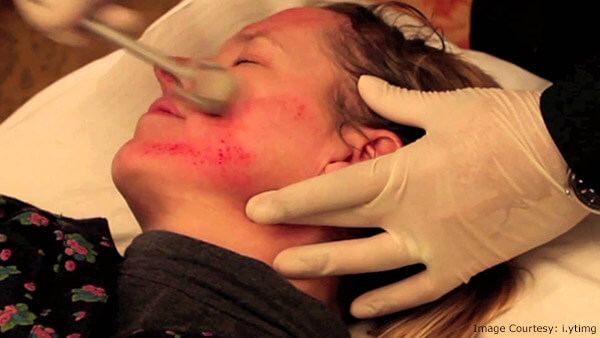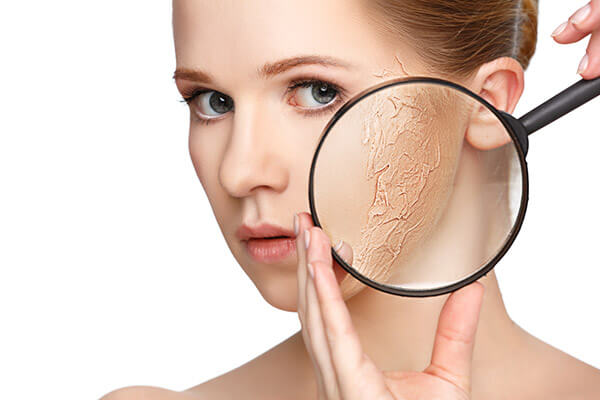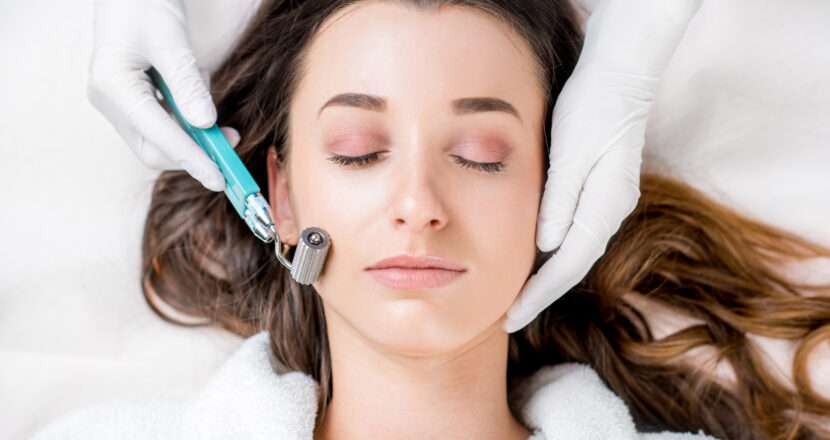What Is Microneedling?
Microneedling, a moderately invasive procedure also known as collagen induction therapy or derma-rolling, has already been around for many years but is just recently gaining popularity as an anti-aging treatment and alternative to injectables and laser treatment.
The process involves creating many micro-injuries into the skin layers using a micro-needling pen, a small device that contains a head filled with tiny needles.
These injuries will stimulate the natural healing process and promote collagen production, giving you thicker, more even-toned skin with reduced lines, wrinkles, and pigmentation.
Unlike other treatments like laser therapy, micro-needling does not cause hyperpigmentation on certain skin types.
The main difference between microneedling vs. microdermabrasion is that microdermabrasion exfoliates to reveal new skin while microneedling stimulates skin renewal from deep within the skin.
However, since it involves puncturing the skin multiple times, it can be really painful. This is why the application of a topical anesthetic is recommended before the procedure.
Microneedling, according to Mashell Tabe, a facialist whose clients include Gwyneth Paltrow, also allows for products to be absorbed faster and deeper into the skin.
This is done by creating microchannels theoretically meant to induce the maximum absorption of topical ingredients and nutrients aside from jump-starting the body’s collagen and elastin production.
Check out these collagen induction therapy before and after pictures to get a view of what it can do:

Microneedling Before And After – Image/Shutterstock
What Happens After Micro Needling Skin Treatment?
Now that you have an idea about what happens during the procedure, you may be wondering what to expect after microneedling.
Read on to find out what happens to your skin:
1. Red skin After Microneedling

Red Skin After Microneedling – Image/Shutterstock
This is normal after micro-needling but should at least subside within 24 hours or longer after more aggressive treatment.
According to Jennifer Reichel, MD, a dermatologist from Seattle, the skin will appear bright red right after the treatment with a sensation similar to a mild sunburn sting.
The inflammation should significantly fade within 12 to 48 hours while redness and sensitivity may persist until after a few days upon the first peeling.
2. Rough Skin After Microneedling

Rough Skin After Microneedling – Image/Shutterstock
Immediately after and for a few days post-procedure, your skin may feel a bit rough to the touch which may be accompanied by some bruising or swelling.
Ava Shamban, MD, a Santa Monica dermatologist[1], says that this swelling can range from mild to severe depending on the microneedling[2] treatment done.
This is due to the skin’s reaction to the injuries similar to an allergic reaction.
3. Visible Marks

Visible Marks On Skin After Microneedling – Image/Shutterstock
The many small injuries caused by microneedling will cause very small, usually faint marks on the skin surface.
These are mostly short-lived and will fade away as the skin heals and recovers.
4. Chances of Breakout After Microneedling

Chances Of Breakout After Microneedling – Image/Shutterstock
While it does improve and remove acne scars, the procedure can spread bacteria on the skin.
Especially if there are active wounds, lesions, or openings in the skin, micro-needling can worsen the condition or cause breakouts.
Dermapen peeling may also trigger a cold sore response in some patients.
So, if you have breakout-prone skin, you should let your doctor know beforehand.
5. Chances of Bleeding

Chances Of Bleeding From Skin After Microneedling – Image/Shutterstock
Dr. Reichel also adds that some pinpoint bleeding is common since needles are inserted into the skin.
This is why some form of sedation or numbing anesthetic is used.
6. Peeling

Peeling Skin After Microneedling – Image/Shutterstock
This answers the question “does your skin peel after microneedling?”.
Peeling can happen 3 to five days after the treatment.
7. Skin Dryness and Flaking

Skin Dryness And Flaking On Skin After Microneedling – Image/Shutterstock
Within two days after a micro needling procedure, there might be some dryness and flaking due to an accelerated and enhanced skin cell turnover rate.
Usually, the skin starts shedding a week later, during which your skin will be very dry.
So, seek your doctor’s advice about the right moisturizer and what to put on the skin after microneedling.
8. Tight Skin

Tight Skin After Microneedling – Image/Shutterstock
Your skin may feel very tight for the first one to three days.
9. Micro Bruising Around The Eyes

Micro Bruising Around The Eye Skin After Microneedling – Image/Shutterstock
Because the skin around the eyes is more sensitive, bruising may occur upon the use of the rollers.
10. Glowing skin

Glowing Skin After Microneedling – Image/Shutterstock
This is the most apparent positive effect of micro needling.
Immediately after the recovery period of the first treatment, you should notice a significant improvement in your skin’s overall appearance and radiance.
Read Next – Underarm Whitening Scrub to get Smoother and Clear Armpits Naturally
How To Treat Your Skin After Microneedling?
There are many post-care after micro-needling methods to take care of your skin to prevent damage, complications, or ill effects.
To make sure you can make the most of the prickly procedure, follow these skin care tips:
- Avoid sun exposure after micro-needling for at least three to ten days. Microneedling will make your skin much more sensitive and open to sun damage.
- Do not apply any sunscreen. Your skin’s channels will be open and applying sunscreen will enhance the toxicity and absorbance of sunscreen’s active ingredients, which will cause harm.
- Likewise, avoid all skin care products with active ingredients like retinol, alpha hydroxy acids, and the like as these can cause irritation.
- Wait for at least four hours after the procedure before washing your skin gently with a mild cleanser and cool or tepid water to remove leftover serums, dead cells, debris, and dried blood. Use clean hands to pat it dry.
- Do not take any anti-inflammatory medications like Advil, Ibuprofen, or Motrin as these can interfere with the treatment’s stimulation of the body’s natural anti-inflammatory response that is vital for your skin’s transformation.
- Some say that fresh pineapple is healthy skin food to eat to relieve discomfort as well as hasten and improve the micro-needling healing process.
- Do not scratch, poke, or pick at the treated skin. This is an important after micro-needling care tip.
- Avoid too much sweating and strenuous exercise at least 12 to 24 hours after the treatment because your pores will open more, exposing your skin to infection and irritation.
- Moisturize and apply a cold compress to help relieve persistent discomfort, swelling, redness, or burning.
- Can you wear makeup after dermaroller treatment[3]? Yes, but wait for at least 12 to 48 hours post-treatment to allow your skin to “breathe” before applying makeup. Aside from toxic chemicals potentially seeping through the open skin channels, the makeup brush bristles can also penetrate the pores and cause irritation. If the brush is unclean or has been used before, it can even spread bacteria and cause infection.
- Avoid toners with alcohol for 10 to 14 days because these will have a painful, stinging effect.
- Post-derma roller care involves using collagen-stimulating peptides to assist in collagen production and recovery.
- Use a cooling face mask to reduce inflammation and redness.
- Use antioxidant serums (like Vichy) to assist in soothing and healing the skin as well as reduce irritation.
- Stay hydrated by drinking more water before and after microneedling. This will help your skin recover and heal faster.
Microneedling may be the solution on how to get flawless skin without dark spots and patches.
However, it requires careful skincare after micro-needling to really reap its benefits and avoid future problems.
Follow the tips given here and ask your doctor about your concerns about micro-needling to get the perfect skin you’ve been dreaming of!
Don’t Miss to Read – 14 Best Anti Wrinkle Cream
FAQ’s:
Que: Is micro needling good for your skin?
Ans: Yes, microneedling restores your skin’s strength and elasticity, which improves firmness to smooth out those fine lines and wrinkles.
Que: What age is best for microneedling?
Ans: This form of treatment should be started in your 20s or 30s to increase collagen production more significantly.
Que: Is microneedling better than Botox?
Ans: Both microneedling and Botox injections are safe and effective for patients with all skin types.
Que: Does microneedling have side effects?
Ans: The procedure causes short-term swelling, redness, and skin flaking, which can last for a few days.
 By Wendy Gould
By Wendy Gould





